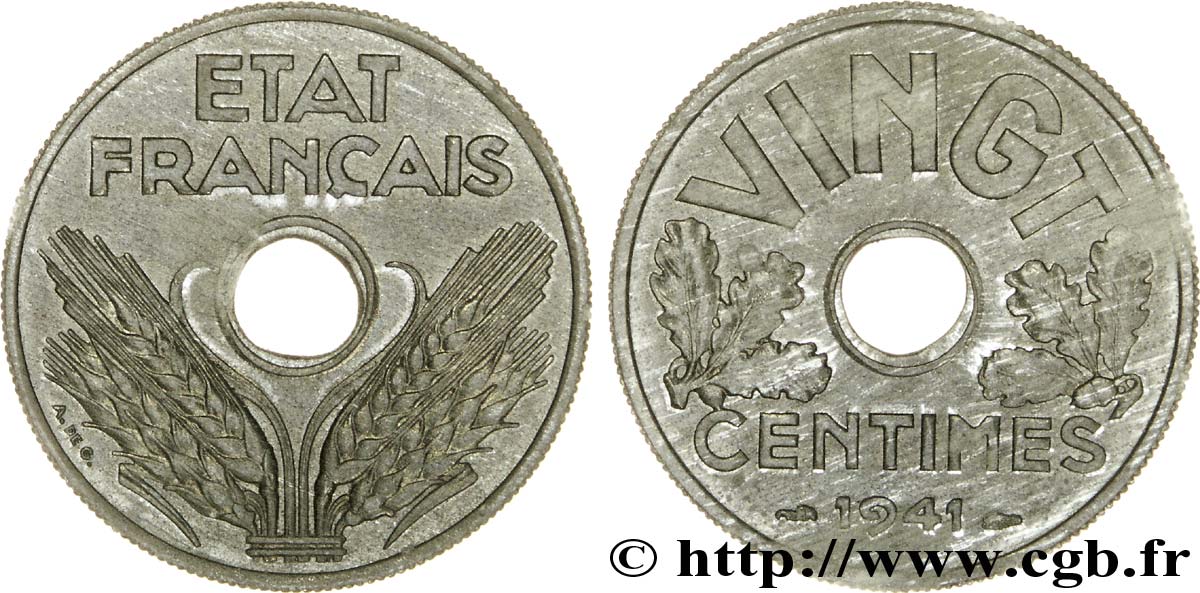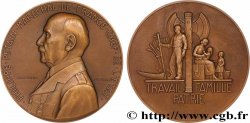v37_1439 - VINGT centimes État français, frappe courante 1941 Paris F.152/2
MONNAIES 37 (2009)
Starting price : 30.00 €
Estimate : 60.00 €
Realised price : 80.00 €
Number of bids : 6
Maximum bid : 120.00 €
Starting price : 30.00 €
Estimate : 60.00 €
Realised price : 80.00 €
Number of bids : 6
Maximum bid : 120.00 €
Type : VINGT centimes État français, frappe courante
Date: 1941
Mint name / Town : Paris
Quantity minted : 54044000
Metal : zinc
Diameter : 24,19 mm
Orientation dies : 6 h.
Weight : 3,55 g.
Edge : striures fines
Coments on the condition:
Aucune trace de circulation mais surface mate et sombre avec des taches blanches dans les champs
Catalogue references :
Predigree :
Cet exemplaire provient de la collection Pierre-2
Obverse
Obverse legend : ETAT / FRANÇAIS.
Obverse description : en deux lignes, au-dessus d'un trou central bordé d'un listel, au-dessous duquel se trouvent quatre épis de blé maintenus par une bague ; à gauche des épis A. DE G..
Reverse
Reverse legend : VINGT / CENTIMES / 1941.
Reverse description : au-dessus et au-dessous d'un trou central bordé d'un listel accosté de deux rameaux de chêne, chacun étant composé de trois feuilles et d'un gland.
Commentary
Cet exemplaire ne semble présenter aucune caractéristique particulière mais sa présence dans la collection Pierre-2 laisse supposer une variante. Peut-être s’agit-il d’un alliage de zinc différent du standard ? En effet, la lecture du Mazard, page 216, montre que des frappes, en 1939, furent faites avec des alliages de zinc variées mais, dans ce cas, les perforations centrales furent elles aussi variées pour les distinguer, ce qui n’est pas le cas ici. Il faudra un jour que le propriétaire de cette pièce trouve une méthode d’analyse non destructive d’un coût raisonnable...
This example does not appear to have any particular characteristics, but its presence in the Pierre-2 collection suggests a variant. Perhaps it is a different zinc alloy than the standard? Indeed, reading the Mazard, page 216, shows that strikes in 1939 were made with various zinc alloys, but in this case, the central perforations were also varied to distinguish them, which is not the case here. The owner of this piece will one day have to find a non-destructive analysis method at a reasonable cost.
This example does not appear to have any particular characteristics, but its presence in the Pierre-2 collection suggests a variant. Perhaps it is a different zinc alloy than the standard? Indeed, reading the Mazard, page 216, shows that strikes in 1939 were made with various zinc alloys, but in this case, the central perforations were also varied to distinguish them, which is not the case here. The owner of this piece will one day have to find a non-destructive analysis method at a reasonable cost.








 Report a mistake
Report a mistake Print the page
Print the page Share my selection
Share my selection Ask a question
Ask a question Consign / sell
Consign / sell
 Full data
Full data













